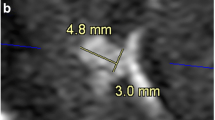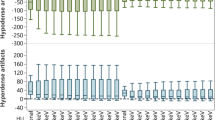Abstract
The natural history of unruptured cerebral aneurysm is not known; also unknown is the potential growth and rupture in any individual aneurysm. The authors have developed transluminal color-coded three-dimensional magnetic resonance angiography (MRA) obtained by a time-of-flight sequence to investigate the interaction between the intra-aneurysmal signal intensity distribution patterns and configuration of unruptured cerebral aneurysms. Transluminal color-coded images were reconstructed from volume data of source magnetic resonance angiography by using a parallel volume-rendering algorithm with transluminal imaging technique. By selecting a numerical threshold range from a signal intensity opacity chart of the three-dimensional volume-rendering dataset several areas of signal intensity were depicted, assigned different colors, and visualized transparently through the walls of parent arteries and an aneurysm. Patterns of signal intensity distribution were analyzed with three operated cases of an unruptured anterior communicating artery aneurysm and compared with the actual configurations observed at microneurosurgery. A little difference in marginal features of an aneurysm was observed; however, transluminal color-coded images visualized the complex signal intensity distribution within an aneurysm in conjunction with aneurysmal geometry. Transluminal color-coded three-dimensional magnetic resonance angiography can thus provide numerical analysis of the interaction between spatial signal intensity distribution patterns and aneurysmal configurations and may offer an alternative and practical method to investigate the patient-specific natural history of individual unruptured cerebral aneurysms.



Similar content being viewed by others
References
Satoh T, Onoda K, Tsuchimoto S (2003) Visualization of intraaneurysmal flow patterns with transluminal flow images of 3D MR angiograms in conjunction with aneurysmal configurations. AJNR Am J Neuroradiol 24:1436–1445
Steinman DA, Milner JS, Norley CJ, Lownie SP, Holdsworth DW (2003) Image-based computational simulation of flow dynamics in a giant intracranial aneurysm. AJNR Am J Neuroradiol 24:559–566
Gailloud P, Khan HG, Albayram S, Martin J-B, Rufenacht DA, Murphy KJ (2002) Pooling of echographic contrast agents during transcranial Doppler sonography: a sign in favor of slow-flowing giant saccular aneurysms. Neuroradiology 44:21–24
Ujiie H, Tachibana H, Hiramatsu O, Hazel AL, Matsumoto T, Ogasawara Y, Nakajima H, Hori T, Takakura K, Kajiya F (1999) Effects of size and shape (aspect ratio) on the hemodynamics of saccular aneurysms: a possible index for surgical treatment of intracranial aneurysms. Neurosurgery 45:199–130
Kerber CW, Imbesi SG, Knox K (1999) Flow dynamics in a lethal anterior communicating artery aneurysm. AJNR Am J Neuroradiol 20:2000–2003
Takeshima S, Murayama Y, Villablanca P, Morino T, Nomura K, Tanishita K, Vinuela F (2003) In vitro measurement of fluid-induced wall shear stress in unruptured cerebral aneurysms harboring blebs. Stroke 34:187–192
Steiger HJ, Poll A, Liepsch D, Reulen HJ (1987) Basic flow structure in saccular aneurysm: a flow visualization study. Heart Vessels 3:55–56
Gobin YP, Counord JL, Flaud P, Duffaux J (1994) In vitro study of haemodynamics in a giant saccular aneurysm model: influence of flow dynamics in the parent vessel and effects of coil embolization. Neuroradiology 36:530–536
Burleson AC, Strother CM, Turitto VT (1995) Computer modeling of intracranial saccular and lateral aneurysms for the study of their hemodynamics. Neurosurgery 37:774–784
Korogi Y, Takahashi M, Mabuchi N, Miki H, Fujiwara S, Horikawa Y, Nakagawa T, O’Uchi T, Watabe T, Shiga H, Furuse M (1994) Intracranial aneurysms: diagnostic accuracy of three-dimensional, Fourier transform, time-of-flight MR angiography. Radiology 193:181–186
Maeder PP, Weuli RA, de Tribolet N (1996) Three-dimensional volume rendering for magnetic resonance angiography in the screening and preoperative workup of intracranial aneurysms. J Neurosurg 85:1050–1055
Adams WM, Laitt RD, Jackson A (2000) The role of MR angiography in the pretreatment assessment of intracranial aneurysms: a comparative study. AJNR Am J Neuroradiol 21:1618–1628
Mallouhi A, Chemelli A, Judmaier W, Giacomuzzi S, Jaschke WR, Waldenberger P (2002) Investigation of cerebrovascular disease with MR angiography: comparison of volume rendering and maximum intensity projection algorithms-initial assessment. Neuroradiology 44:961–967
Sevick RJ, Tsuruda JS, Schmalbrock P (1990) Three-dimensional time-of-flight MR angiography in the evaluation of cerebral aneurysms. J Comput Assist Tomogr 14:874–881
Bosmans H, Wilms G, Marchal G, Demaerel P, Baert AL (1995) Characterization of intracranial aneurysms with MR angiography. Neuroradiology 37:262–266
Wilcock DJ, Jaspan T, Worthington BS (1995) Problems and pitfalls of 3-D TOF magnetic resonance angiography of the intracranial circulation. Clin Radiol 50:526–532
Piotin M, Gailloud P, Bidaut L, Mandai S, Muster M, Moret J, Rufenacht DA (2003) CT angiography, MR angiography and rotational digital subtraction angiography for volumetric assessment of intracranial aneurysms. an experimental study. Neuroradiology 45:404–409
Jager HR, Ellamushi H, Moore EA, Grieve JP, Kitchen ND, Taylor WJ (2000) Contrast-enhanced MR angiography of intracranial giant aneurysms. AJNR Am J Neuroradiol 21:1900–1907
Satoh T (2001) Transluminal imaging with perspective volume rendering of computed tomographic angiography for the delineation of cerebral aneurysms. Neurol Med Chir (Tokyo) 41:425–430
Satoh T, Onoda K, Tsuchimoto S (2003) Intraoperative evaluation of aneurysmal architecture: comparative study with transluminal images of 3D MR and CT angiograms. AJNR Am J Neuroradiol 24:1975–1981
Author information
Authors and Affiliations
Corresponding author
Rights and permissions
About this article
Cite this article
Satoh, T., Ekino, C. & Ohsako, C. Transluminal color-coded three-dimensional magnetic resonance angiography for visualization of signal Intensity distribution pattern within an unruptured cerebral aneurysm: preliminarily assessment with anterior communicating artery aneurysms. Neuroradiology 46, 628–634 (2004). https://doi.org/10.1007/s00234-004-1239-6
Received:
Accepted:
Published:
Issue Date:
DOI: https://doi.org/10.1007/s00234-004-1239-6




